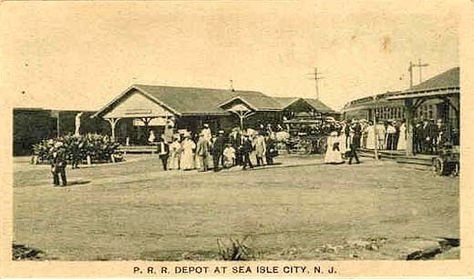By BOB THIBAULT
From the Camden Morning Post of July 8, 1887:
“Three robberies were committed at Sea Isle City on Wednesday night.
H.R. Hecker & Co.’s hardware store was broken into and $15 in cash and a revolver were taken.
The West Jersey Railroad station was also entered and the money drawer, containing about $10, rifled. An attempt to blow open the safe was made.
The post office and confectionery of W.R. Bryant was also entered and cigars, a lot of tobacco and several smaller articles were stolen.”
Seems like relatively small change. But when the scene gets multiplied many times over, the pot can become pretty sizable. Here’s the story as reported by the Camden and Philadelphia papers, the Boston Globe, and even the New York Times.
A plot takes shape:
In early July of 1887, two young men from Cumberland County found themselves in Ocean City with the intent to do mischief. They were the Mulkurn brothers, Thomas and Timothy, the latter described as “a tall, awkward, country looking young fellow.”
The boys first practiced by looting a few stores in the neighborhood. Then they turned their hand toward the railroad station. Whether by design or by serendipity, there in front of them stood a strange, lopsided iron contraption with three wheels, two on one side and one on the other.
It was what railroad men called a “track tricycle.” Relatively light-weight, it was made to fit across standard gauge train tracks and was propelled by human power.
The tricycle found at the Ocean City Station was reported to have ample room for two, plus a few carry-ons. It was unusual in that it was driven by a treadle with a continuous chain, sort of like a combination sewing machine/bicycle, allowing it to reach speeds of up to 20 miles per hour. It was capable of maneuvering freely and endlessly up and down the tracks, unless a real train got in the way.
The particular machine eyed by the Mulkurn brothers was the property of the Sea Isle City Railroad and was normally used by the section foreman to patrol the tracks between Sea Isle and Ocean City.
But the boys didn’t care much about track maintenance. They saw this oddly shaped tricycle as something else – the perfect getaway vehicle.
They didn’t require great speed because they had the ideal stealth machine. It was fast enough, it was invisible at night, it was small, it was quiet, it left no clues behind. And it could be carried off the tracks to hide in the bushes to avoid pursuit or the occasional onrushing locomotive, whose schedule they seemed to know. It was like a magic carpet. Thomas and Timothy knew what they were doing.

The crime spree:
The Mulkurn brothers now possessed loot from three stores in Ocean City plus the potential means of transporting it home to Rosenhayn in Cumberland County. More importantly to them, they now had the wherewithal to do a lot more mischief across the state – anywhere trains traveled, and there was a lot of track.
First they had to get away from Ocean City. According to newspaper accounts, “On this novel machine, the burglars piled the most valuable of their plunder and worked their way to Sea Isle Junction, thence to the West Jersey railroad and escaped.”
Over the next four weeks, Thomas and Timothy Mulkurn were conservatively credited with more than 20 burglaries stretching across the four counties of Cumberland, Cape May, Camden, and Atlantic. Also according to accounts, they “caused intense excitement” and “terrorized South Jersey” while they were doing it.
They naturally specialized in train station pilfery because most were unguarded at night and just a few steps from the tracks. And the stations were usually good for stamps, tickets, portable small items of value, and some hard cash. They’d smash and grab, then hop on their tricycle and whisk away into the night without leaving a clue.
The first station on the agenda was the West Jersey depot in Sea Isle City on what is now JFK Boulevard. This probably corresponds to the report quoted in the Courier Morning Post cited above. When that report was written, nobody yet had any idea whodunit or how they did it. It was just the beginning.
For probably their biggest haul, the Mulkurns treadled their trike down to Hammonton to visit Trowbridge’s General Store, where they scooped up about $500 worth of goods. The town merchants were so intimidated that they chipped in a considerable reward for the capture of these villains. Adding it up, reward monies from all sources in the state totaled hundreds of dollars.
The brothers became so bold that they started entering private homes during the day. Yet it is nowhere stated that anyone ever observed them at their work. And as far as we know, no one was ever hurt, or even threatened, by the boys and their tricycle.
It was reported that “officers by the score” were on their trail. The railroads even hired Special Detective Doak to ferret out the burglars. But the law always seemed a step behind. Then things changed, and very quickly.

Captured:
Over the space of a week in late July of 1887, it all unraveled:
- Winslow constable Bowman Bates noticed a suspicious-looking man crossing a field carrying a bag which, when opened, produced several cans of condensed milk stolen from Tillyer and Brothers. Bates escorted the man to the Camden jail where he claimed his name was John Kurns. Several days later, he was identified as Thomas Mulkurn.
- Mulkurn admitted he had walked off with a few items from Tillyer and Brother’s. A portion of the stolen goods was recovered that night in the woods near Winslow.
- Thomas also confessed to having broken into Trowbridge’s in Hamilton and hidden most of the proceeds from that heist in the loft of the railroad station at Elm. Constable Bates promptly scooted over and rescued a large quantity of pants, vests, shirts, and coats from the loft.
- Meanwhile, Detective Doak was on the job searching for the getaway vehicle. He finally discovered the tricycle hidden in the bushes near the West Jersey station in Clayton.
- Doak observed a “roughly dressed stranger” with a heavy valise at the Clayton station boarding the train for Camden. Doak wired ahead and the stranger was arrested. He gave his name as Thomas Gladden but was soon identified as the other half of the burglar brothers, Timothy Mulkurn.
- Timothy was loaded down with plunder. His valise held items stolen from Tillyer and Brother’s. In his pockets were found two gold watches and other jewelry, four purses containing $96.27, cigars, a revolver, and several burglar tools such as skeleton keys and a diamond glass cutter. As the clincher, he was wearing clothes recently provided unwillingly by Trowbridge’s in Hammonton.
- When arrested, Timothy had been on his way to a boarding house in Philadelphia. When searched, the place yielded stolen clothing, cigars, cigarettes, silver spoons, plus other engraved silverware.
- It was really hard to mount a defense against such evidence, so Timothy confessed. Both brothers were now in custody, courtesy of the Camden jail.
- Subsequently, Timothy Mulkurn was delivered to the Cape May County authorities, and committed in default of $5,500 bail by the mayors of Ocean City and Sea Isle City.
It had been a hectic, frightening time, but it was finally over. We don’t know what eventually happened to the boys, but probably nothing good.

This “Spotlight on History” was written by Sea Isle City Historical Society Volunteer Bob Thibault.
Unless otherwise noted, photos were provided courtesy of the Sea Isle City Historical Museum.
To enjoy a collection of photos, literature and artifacts, please visit the Sea Isle City Historical Museum at 48th Street and Central Avenue. Access the website at www.seaislemuseum.com. Call 609-263-2992. Hours are 10 a.m. to 3 p.m. on Monday, Tuesday, and Thursday and 1 p.m. to 3 p.m. on Friday. Admission is free.








